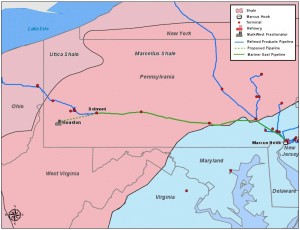Even without wells, fracking has big impact on Delaware River watershed
Posted by Jeff Montgomery, Delaware OnLine, September 23, 2013
Article Photo: Sunoco Logistics map, Mariner East pipeline
Regardless of the Delaware River Basin Commission’s long delay in voting on rules for natural gas well hydraulic fracturing — or “fracking” — in the agency’s huge watershed, the industry is continuing to put down roots along the Delaware River and across the region.
Proof of that can be found Tuesday through Thursday at the Marcellus Shale Coalition’s third annual conference at the Philadelphia Convention Center, where organizers have had to produce a 48-page program to help those attending wade through the offerings. Some of the energy industry’s bigger names will be there, as will former Republican house speaker and conference keynoter Newt Gingrich.
Protesters will likely be there in abundance, too. Expect to see members of environmental groups unhappy over pollution and risks associated with fracking, and watershed property owners and drillers who see regulatory inaction as a threat to their property rights and investments.
The Army Corps of Engineers has offered its own proof that fracking has settled in, releasing a draft supplemental environmental assessment for Sunoco’s proposal to develop a shipping and export pier at it’s former oil refinery along the Delaware at Marcus Hook, Pa., just a few hundred feet north of the Delaware-Pennsylvania line.
The new pier facilities would support loading of tankers with ethane from natural gas liquids collected as byproducts at fracking wells in other watersheds as far away as Ohio. Some of those liquids would be transported via a 70,000 barrel-per-day pipeline from a hub in western Pennsylvania.
Natural gas fracking wells produce huge amounts of leftover liquids rich in ethane, butane and propane, hydrocarbons that have plenty of uses in plastics and other industries both in America and overseas. As a result, pipelines are being drawn on maps or put in the ground from the Marcellus shale region to the big petrochemical complexes of Texas, to other locations and to Marcus Hook, where the region’s energy exporting business will get another substantial bump.
Public comment collection on the Marcus Hook proposal already has ended, and the Corps has already tentatively determined that it sees “no substantial impact.” Pennsylvania regulators have separately found that the plan is consistent with that state’s Coastal Zone management law.
For its part, the DRBC has for nearly two years put off a vote on regulations that would allow use of hydraulic fracturing techniques to breakup gas-bearing rock deep underground inside the Delaware’s own 13,500 square mile watershed.
Gov. Jack Markell helped put those rules in limbo in November 2011 by openly declaring concern about the adequacy and protectiveness of the DRBC’s draft fracking regulations. New York was drawing up its own oversight program at the time and Pennsylvania’s were in flux, although furious drilling has been under way with enthusiastic government support for years in other watersheds of the Commonwealth.
New Jersey, like Delaware, is outside the shale gas region, but environmental groups there have opposed fracking in that state, and argued that the Garden State could become a wastewater treatment mecca for the industry. So Markell’s public stand allowed the DRBC to table the whole thing and spared the governors of New York and New Jersey an uncomfortable face-off with Pennsylvania.
Drilling, debates and uncomfortable face-offs have continued elsewhere, however.
The Delaware Riverkeeper, working with dozens of other groups, has sponsored a long series of public programs and campaigns opposing fracking, and plans a three-day “Shale Gas Outrage” protest and information campaign during the Philadelphia convention. [See FrackCheckWV on September 22nd.]

